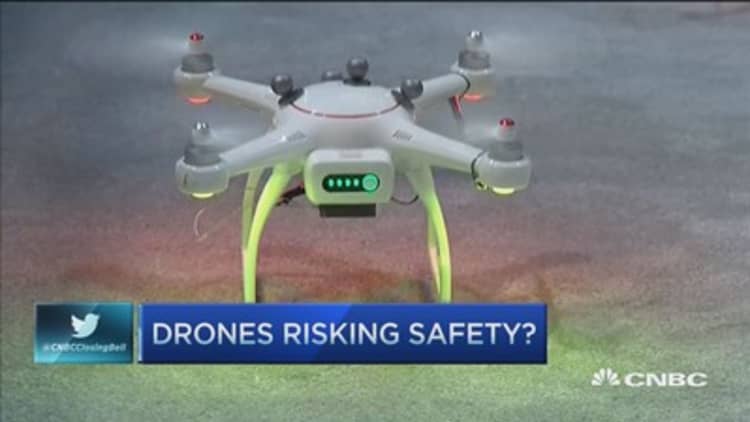When Amazon pushed for drone delivery before Congress this summer, it put big technology at the front of corporate efforts to use the aircraft.
But it's not just big tech companies that are pushing Washington to expand general use of drones, also called unmanned aerial vehicles. Twenty groups—from large tech and defense companies to media conglomerates, real estate agents and agriculture—cited "unmanned aerial vehicles" while lobbying the federal government in the second quarter, up from nine mentions in the previous year.
That wide range of potential applications also means that the technology is subject to competing regulatory jurisdictions—a situation that threatens to complicate the effort to solidify rules for use of the fast-growing technology.
"When you have an environment like that, sometimes it's tough even for the best organized interests [to get their preferred outcome]. Despite lots of advocacy efforts, the industry itself is having a hard time coming to a consensus around terms," said Greg McNeal, a law professor at Pepperdine University and drone policy expert.
In February, the Federal Aviation Administration—which has primary regulatory authority over drones—proposed regulations on the private use of drones weighing less than 55 pounds that would limit usage to daylight, and require drones to be kept within the operator's line of sight. (The agency has since taken public comments on the proposal.) The agency has also issued temporary licenses and certifications to some companies for commercial purposes on a case-by-case basis. Speaking before Congress this summer, FAA Deputy Administrator Michael Whitaker said revised rules could be ready within a year.
But they may not come fast enough to appease large businesses, which have recognized drones' transformative potential. Possible commercial applications include package delivery, photography or spraying pesticides on crops.
The use of drones could add $82 billion and 100,000 jobs to the U.S. economy by 2025, according to industry group Association for Unmanned Vehicle Systems International. Amazon this summer said it planned to have its Prime Air delivery ready to launch by the time the FAA sets guidelines.
Read MoreManagers are using drones to monitor their employees
"Companies have really waited with bated breath for what the FAA is going to do," said David Swindell, director of the Center for Urban Innovation at Arizona State University and a drone policy expert.
The FAA and AUVSI declined to comment on the record. But the FAA faces a difficult task in molding rules to fit the broad range of corporate functions.

It makes no sense to apply the same set of rules to 55-pound and one-pound aircraft under the same rules, said Pepperdine's McNeal. For example: It would be "onerous" to put small drones used for surveying and photography under the same certification and flight path standards as larger drones made for tasks such as hauling goods or defense, he said.
Read MoreSilicon Valley's biggest names team up on drones
Deploying drones more widely also increases the chances of disrupting aircraft flight, and the FAA has acknowledged that close calls are rising. The prospect of more drones in the sky has also fueled concerns about consumer privacy and government surveillance, an area in which the FAA does not hold jurisdiction.
"There's a big battle we're seeing between the forces of commerce and innovation and the forces of security and safety," said Jay Stanley, a senior policy analyst with the American Civil Liberties Union's speech, privacy and technology project.
The National Telecommunications and Information Administration, an arm of the Department of Commerce, is working with the FAA to field concerns about privacy and transparency. The office has taken public comment and will hold stakeholder meetings in the coming months to devise a recommended set of best practices to protect civil liberties.
Read MoreFAA: Close call reports with drones soar in 2015
And since drones are controlled by signals sent through the air-wave spectrum, the Federal Communications Commission also has some jurisdiction over their use. If the FAA lets drones fly out of an operator's sight for uses such as package delivery, the FCC may need to take a larger role in sorting frequencies and limiting potential attempts to disrupt signals, Swindell said.
He added that issues with drones carrying mobile Internet hot spots could draw in the FCC, which did not respond to a request to comment. It adds up to a confusing landscape at a time when many companies look to expedite drone use.
In the absence of broad federal regulations, many state and local governments have drafted drone rules that have been "all over the board," Swindell said. He and Arizona State colleagues are now working with local lawmakers on regulations that aim to balance consumer considerations, like flight over private property, with drone use that serves the public interest.
"We're trying to find that balance of these two main competing interests that a lot of local governments simply are not doing," he said.


